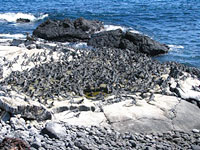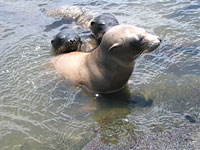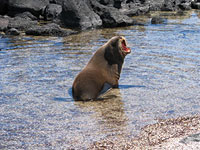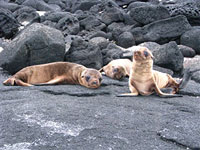

 | |||||||||||||||||||||||||
|
|
Journals 2008/2009Tom Bogard
September 9, 2008 Hello Fernandina! Fernandina is considered to be the most pristine of all the islands. It has the fewest documented invasive species. Even though there was a language barrier it was obvious to me that the survey crew held the island in the highest regard and reverence. I am still not feeling well and have not been eating much more than some plain white rice. I did feel well enough to go on the morning's survey. Most of the day's survey was conducted from shore. The area that we were in is completely off limits to everyone except the occasional scientific expedition with the proper permits. Because of its biological richness, the area at one time was a favored spot for poachers to operate from. When we landed I could immediately see why. What in incredible amount of life there was in a relatively small area! To support such populations the waters here must be exceptionally rich in nutrients. The Marine Iguanas are so numerous that it is impossible to count them individually. The best that we could do was estimate. The method that was suggested was to count 100 iguanas in an area and get an idea of what that looked like. Use this sample as an example to count the iguanas in groups of 100. The iguanas were basking in the sun EVERYWHERE! Our final estimate was over 10,000 individuals! At one point as I was walking I thought how unusual that the ground was muddy. I quickly realized that it was a very sunny day and that I was walking on exposed volcanic rock - no soil. The "mud" was the accumulation of iguana droppings on the rocks! It was amusing to see the iguanas scurry away as we walked through their colonies. The Galapagos Marine Iguanas are the only species of iguana in the world that feed in the open ocean. In the morning they bask in the sun until their body temperatures rise sufficiently to allow them to feed in the cold water. Once they have reached this temperature, they use their powerful tails to swim out and then dive to the bottom to feed on algae. They use their long strong claws to grasp and hold the rocks while they feed on the algae that grow on them. The water is so cold that the iguanas must come back to shore to bask in the sun to bring their bodies back up to temperature so they can digest their food. Sea Lions! There was an amazing abundance of Galapagos Sea Lions here. Andrea, Pete, and I took some time to observe them. There were adults, pups, and juveniles of all ages. Sea Lions are exceptionally curious creatures. There was a large, relatively deep, tide pool that had what looked to be a colony of females with their young all under the watchful eye of a dominant male. The pups and juveniles were playing great Sea Lion games in the water. The play seemed to go on until they were exhausted and then they would climb onto the land and fall asleep in the warmth of the sun. As Andrea and I approached the pool their attention was immediately turned towards the new visitors. We sat down and put our legs into the water, the pups came up to within a third of a meter from us! They would poke their heads up out of the water to check us out, sometimes pushing each other out of the way just to get the best vantage point. They would swim quickly away, only to return for another look, then another, and another. Off on the other side of the pool other pups and juveniles were chasing each other, sometimes leaping out of the water. Near the shore I say a mother nursing her pup - I stayed away from her, not wanting to disturb her feeding. Pete pointed out a mother that was coaxing and pulling here very young pup into the water - probably teaching it to swim for the very first time. There is no way that words can even come close to describing this experience with the Sea Lions! Amazing! Pete had warned us that the dominant males are very territorial and would view us as rivals and that we had to keep an eye on them at all times. The males can violently protect their territories; I saw one bloodied male to attest to this. While we were at the tide pool we lost site of the male. He had moved somewhat behind us and to our left side. Apparently we had overstayed our welcome and he charged us! For large finned mammals they move very fast on land - for a while he moved faster than we could run. Thankfully as we crossed the invisible boundary that he considered his territory he stopped chasing us. Whew! One other time I crossed the invisible boundary and was chased off by another male protecting his territory and harem. Thankfully the dominant males were, for the most part, tolerant of our presence and would vocalize warnings if we got too close. Just all part of the grand adventure! I saw more Green Sea Turtles in the water and on the beach; one pair was copulating in the water. I also saw Oyster Catchers with their brilliant orange beaks, yellow eyes ringed in orange, and long legs - fascinating birds. The day's survey was very successful. Over 50 penguins were counted and PIT tags were found in two of cormorants. The good Queen Mabel did not disappoint and gave us another exciting ride on our afternoon transit. She was pitching and rolling, her bow smashing down into the troughs of the waves sending water spraying outward. There did not seem to be any organization to the waves. For a time the Captain had to throttle back due to the roughness. It was difficult to walk in the boat. I stayed in the main cabin or my cabin, not wanting to chance the narrow exterior walkway to the stern or bow. Good-bye Fernandina, back to Isabella!
|
||||||||||||||||||||||||





